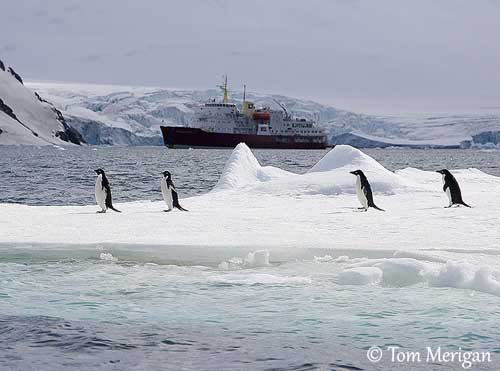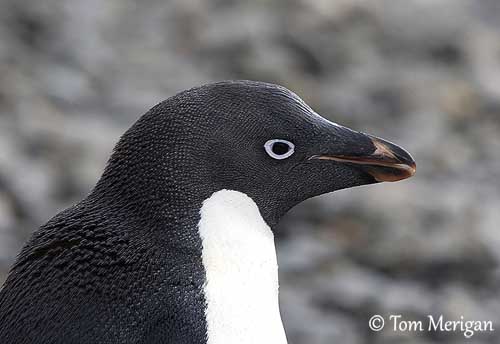
Fr: Manchot d’Adélie
All : Adeliepinguin
Esp : Pingüino de Adelia
Ital : Pinguino di Adelia
Nd: Adéliepinguïn
Sd: Adeliepingvin
Photographer:
Tom Merigan
Tom Merigan’s Photo Galleries
Text by Nicole Bouglouan
Sources:
HANDBOOK OF THE BIRDS OF THE WORLD vol 1 by Josep del Hoyo-Andrew Elliot-Jordi Sargatal - Lynx Edicions - ISBN: 8487334105
BirdLife International (BirdLife International)
Animal Diversity Web (University of Michigan Museum of Zoology)
ANIMALS – Explore, discover, connect
Penguins of the world (Mike Bingham)
Wikipedia, the free encyclopaedia
Adelie Penguin
Pygoscelis adeliae
Sphenisciforme Order – Spheniscidae Family
INTRODUCTION:
The name of the Adelie Penguin pays tribute to Adelie d’Urville, the wife of the French polar explorer Dumont d’Urville (1790-1842).
The Adelie Penguins are living in the southernmost coldest parts of the range, and this anomalous distribution could have originated from their peculiar diet. This species feeds mostly on small krill of order Euphausiacea, and has been recorded occasionally at depths of 175 metres.
DESCRIPTION OF THE BIRD:
Biometrics:
Length: 69-71 cm
Weight: 3600-4500 g
The medium-sized adult has black head, upperparts, flippers and long, wedge-shaped tail. The underparts are white, except the pale pink under flippers.
The bill is pinkish with black culmen, cutting edges and tip. The base is well feathered, covered with short black feathers. The eyes are dark, surrounded by conspicuous white eyering. Short legs and webbed feet are pink with black claws.
Both sexes are similar.
The juvenile has white throat and chin, and black eyering.

RANGE:
The Adelie Penguin has circumpolar distribution, and is common along the entire Antarctic coast.
HABITAT:
The Adelie Penguin is marine. It breeds on ice-free rocky coasts, usually in higher ground than the Gentoo Penguin. The large colonies occupy extensive open areas and can be far from open sea.
CALLS ANS SONGS: SOUNDS BY XENO-CANTO
The Adelie Penguin tends to communicate more by posturing and displays than by sounds. However, both members of a pair use calls to identify each other and their chicks in a dense colony.
BEHAVIOUR IN THE WILD:
The Adelie Penguin feeds primarily on krill (Euphausia superba). It also takes smaller quantities of fish, amphipods and cephalopods.
It catches its prey by pursuit-diving, usually less than 20 metres down. But this species has been recorded at 175 metres depth. It often feeds by night.
They may fish in groups to increase efficiency of finding preys, but also to reduce risk of predation.
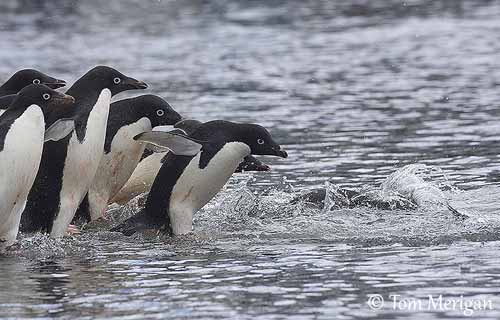
Social behaviour such as territorial and courtship displays are highly developed in dense colonies. Communication with neighbours is established through various postures and displays.
The paired birds protect their nest-site and display in front of it.
Courtship displays include a “salute” in which a male stands a few metres away from a female and performs posturing with beak-thrusting, neck-arching and reaching its full height. Flipper-waving and vocal displays occur too.
In early spring, males arrive first at their breeding grounds. Each pair use the mating calls for recognition, and comes back to the nesting-site yet used previously.
They form dense colonies of thousands of birds. The Adelie Penguin needs to walk a fairly long distance for feeding in coastal waters, sometimes up to 50 km. but this species is agile and able to walk at speeds of 2,5 km/hour.
But across the snowy ground, they slide on their bellies across the snow while flippers and feet propel the bird forwards.
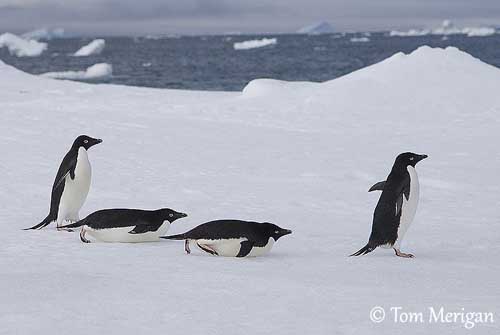
The Adelie Penguin is dispersive after the breeding season. The adults moult outside the colony, usually on ice floes. They move N to reach good feeding areas with abundant food resources.
The immature birds remain between two and five years in areas of pack ice, before to return to their natal colony, usually two or three months later than adults.
Like other penguins, the Adelie Penguin moves by “porpoising”, flopping regularly in and out of water, or by skimming above the surface before splashing back down.
On land, this penguin walks upright while waddling or may progress by two-footed jumps, or slides on its belly over both snow and ice (toboggan).
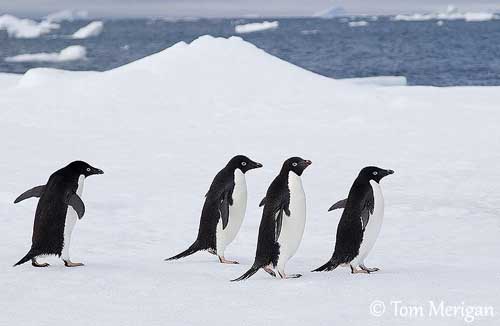
REPRODUCTION OF THIS SPECIES:
They arrive at colonies in September/October, and the laying usually occurs in November.
They breed colonially and may form huge aggregations, usually in discrete areas. Nests are very close to each other.
The nest is a shallow depression on the ground, lined with pebbles, slightly higher than the surrounding area. The male arrives first and starts the nest building. Later, after some displays and recognition, both mates build the nest.
These penguins are known to steal stones from other nests.
The female lays two eggs. A replacement laying may occur if the eggs are lost, but with a single egg. Both parents incubate during 30-43 days (35-37 days for the first egg, and a few days more for the second). Stints can last 7-23 days, and the female usually takes shorter first stint.
The chicks are covered first in pale grey down, darker on the head. The second down is dark brown. They join large crèches at 16-19 days of age and fledge about 50-56 days after hatching.
They are fed by regurgitation of krill. They become independent at two months old.
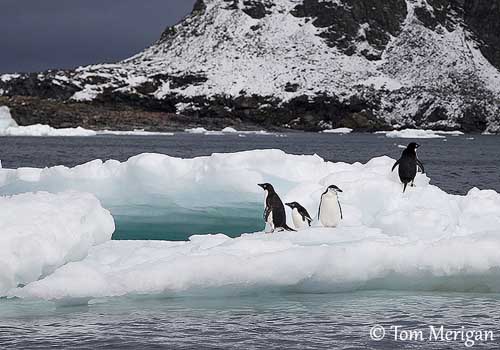
With a Chinstrap Penguin
(fullface)
PROTECTION / THREATS / STATUS:
The Adelie Penguin is preyed upon by leopard seals, killer whales and South Polar Skuas.
In spite of large numbers, this species is vulnerable to climate change, especially with decreases in sea ice concentration. Colonies are disturbed by human activities such as installation of scientific stations, involving reduction of suitable breeding grounds, frequent visits to colonies, and helicopters flying overhead.
Decreases begin to be reported in some areas, and the Adelie Penguin is currently evaluated as Near Threatened.
